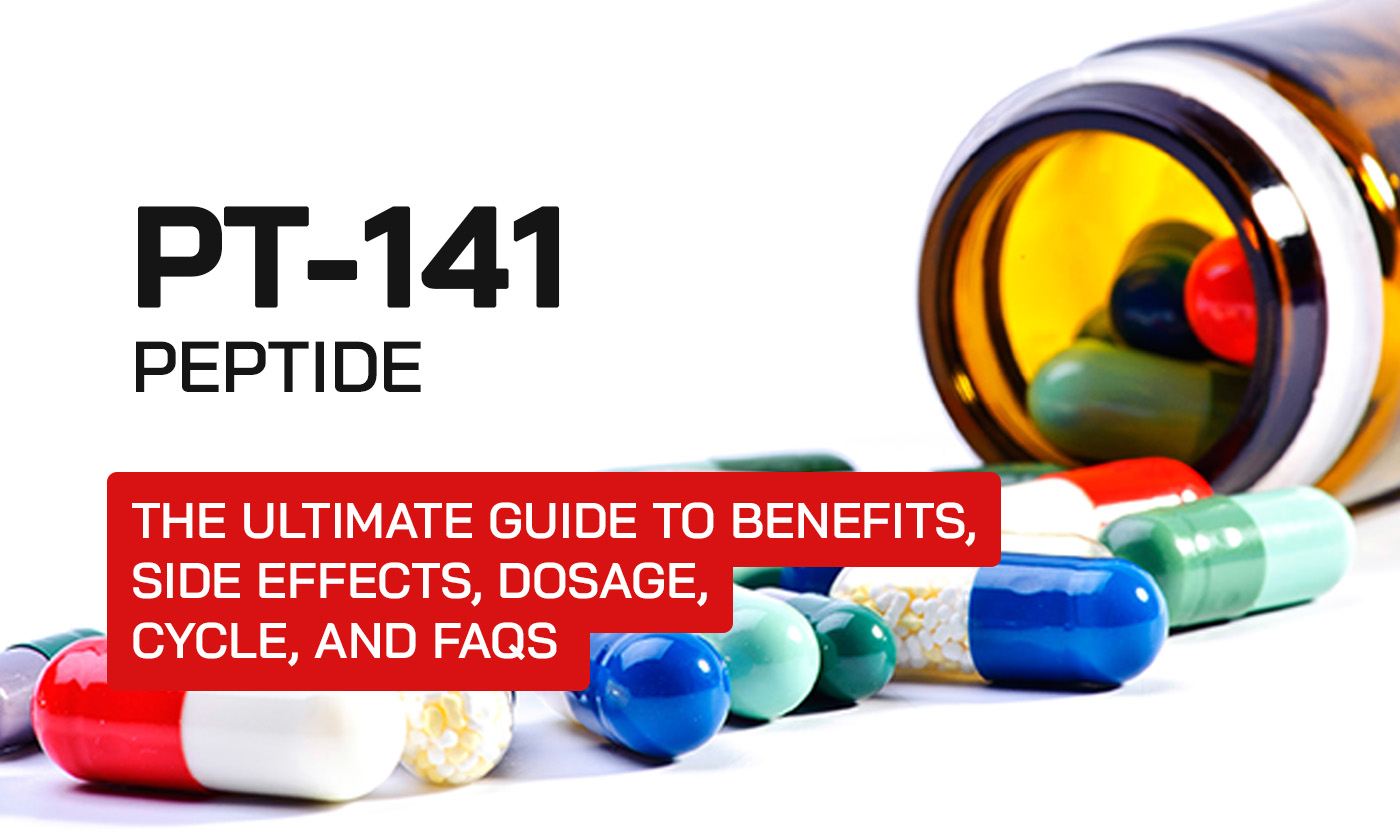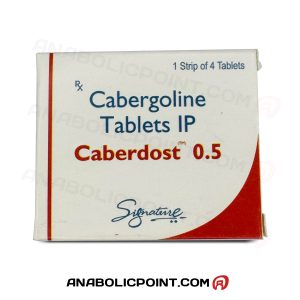Your basket is currently empty!
PT-141 Peptide: The Ultimate Guide to Benefits, Side Effects, Dosage, Cycle, and FAQs

Introduction to PT-141
PT-141, also known as Bremelanotide, is a synthetic peptide primarily used to enhance sexual arousal and libido. Unlike other peptides, PT-141 does not directly affect hormone levels like testosterone or estrogen; instead, it works by targeting the central nervous system (CNS) to stimulate sexual desire and arousal. Initially developed for the treatment of sexual dysfunction, PT-141 has gained popularity in both medical settings and among individuals looking to improve their sexual performance and wellness.
This article provides a comprehensive guide on PT-141, including its history, mechanism of action, benefits, side effects, dosage and cycle, post-cycle therapy (PCT), and answers to the most common questions people have about this peptide.
What is PT-141?
PT-141 (Bremelanotide) is a peptide hormone that belongs to the class of melanocortins, which are derived from the melanocortin peptide family. It was originally developed as part of research into skin tanning products, as it shares similarities with another peptide called Melanotan II, which is known for its ability to stimulate the production of melanin in the skin.
However, during clinical trials, researchers discovered that PT-141 had a unique side effect: it significantly increased sexual desire in both men and women. This led to the development of Bremelanotide as a potential treatment for sexual dysfunction and libido issues.
Unlike many other sexual enhancers, PT-141 works via the central nervous system (CNS) rather than the hormonal pathways, making it distinct from medications like Viagra or Cialis, which target the circulatory system.
History of PT-141
The history of PT-141 can be traced back to the early 2000s, when researchers at Palatin Technologies were working on a melanocortin receptor agonist. Their initial goal was to develop a substance that could darken the skin as a tanning agent, but along the way, they discovered that PT-141 had a profound effect on sexual arousal.
As a result, the focus of PT-141’s development shifted from tanning to sexual wellness. Clinical trials revealed that PT-141 could improve sexual desire and function in individuals suffering from erectile dysfunction, female sexual dysfunction, and other libido-related issues.
In 2019, the FDA approved Bremelanotide under the trade name Vyleesi for use in women suffering from hypoactive sexual desire disorder (HSDD), a condition characterized by low sexual desire. Although still primarily prescribed for sexual dysfunction, PT-141 is now gaining attention for its potential use in improving general sexual wellness and arousal.
How PT-141 Works Technically
PT-141 acts on the melanocortin receptors, specifically the MC4 receptor, which is located in the hypothalamus of the brain. The hypothalamus is the region of the brain that plays a central role in regulating sexual behavior, appetite, and mood.
When PT-141 binds to the MC4 receptor, it triggers a series of neurotransmitter releases that ultimately result in increased sexual arousal. Unlike traditional sexual enhancers like Viagra or Cialis, which primarily focus on increasing blood flow to the genitals, PT-141 acts on the brain and nervous system to enhance the body’s natural sexual responses.
One of the key ways that PT-141 differs from other sexual enhancers is that it works independently of the vascular system. This means that it is effective for both men and women, regardless of issues related to blood flow or erectile function. By stimulating the CNS, PT-141 can increase sexual desire, even in those who may not experience physical sexual dysfunction.
Benefits of PT-141
PT-141 is mainly used for enhancing sexual function, but it has several other potential benefits, especially for those looking to improve their overall well-being.
1. Improved Sexual Arousal
PT-141 is well-known for its ability to increase sexual arousal in both men and women. This is one of its primary uses and is particularly effective for individuals with hypoactive sexual desire disorder (HSDD) or those experiencing sexual dysfunction due to medication side effects, stress, or other factors.
2. Increased Libido
By stimulating the brain’s melanocortin receptors, PT-141 can enhance libido and sexual motivation. It is especially beneficial for individuals who struggle with a lack of desire or low sexual drive.
3. Enhanced Performance and Satisfaction
Many users report improved sexual performance and satisfaction when using PT-141. It may lead to more intense orgasms, improved sexual stamina, and heightened pleasure during sexual activity.
4. Potential Weight Loss
Some studies suggest that PT-141 may have a role in appetite suppression and fat loss. This effect is related to the peptide’s ability to influence the brain’s regulation of hunger and energy expenditure.
5. Potential Mental Health Benefits
Although not primarily researched for mental health, PT-141 has been associated with mood enhancement. Some users report feeling more positive and confident, likely due to the improvements in sexual health and well-being.
Side Effects of PT-141
While PT-141 is generally well-tolerated, it can cause some side effects in certain individuals. These are typically mild and temporary, but it’s important to be aware of them.
1. Nausea
One of the most common side effects of PT-141 is nausea. This can occur, especially when the peptide is first used or when taken at higher doses.
2. Flushing
Some users experience a feeling of warmth or flushing in the face, chest, or other areas of the body. This is typically a short-term effect and can be mitigated by reducing the dosage.
3. Headaches
Headaches are a potential side effect, especially when higher doses of PT-141 are used. If this occurs, reducing the dosage may help alleviate the problem.
4. Increased Blood Pressure
Though rare, PT-141 may cause a slight increase in blood pressure. Individuals with high blood pressure or cardiovascular conditions should consult a doctor before using PT-141.
5. Insomnia
Some users report experiencing insomnia or disrupted sleep patterns, likely due to the stimulating effects of the peptide on the central nervous system.
Dosage and Cycle of PT-141
The dosage of PT-141 will depend on the individual’s response, their goals, and the severity of their sexual dysfunction. Here’s an overview of typical dosages and cycle length:
Dosage Guidelines:
- Initial Dose: 0.5 to 1 mg subcutaneously (under the skin).
- Recommended Dose: 1 to 2 mg per injection, taken 30-60 minutes before sexual activity.
- Maximum Dose: 2.5 mg per injection.
PT-141 can be administered subcutaneously (under the skin) using an insulin syringe, usually in the abdomen or thigh. It is often used on-demand, meaning it’s taken shortly before anticipated sexual activity.
Cycle Length:
PT-141 is not typically used in long cycles like performance-enhancing peptides. It’s often used on an as-needed basis to enhance sexual desire and performance, with no need for a set “cycle length.”
However, for those looking to use it regularly for sexual dysfunction, a typical regimen might involve taking the peptide a few times a week for several weeks, followed by a break or reduction in dosage.
Post-Cycle Therapy (PCT)
PT-141 does not significantly affect hormone levels or suppress the body’s natural function, so post-cycle therapy (PCT) is generally not required after using the peptide. However, if PT-141 is used in conjunction with other substances that affect hormonal balance, PCT may be necessary.
10 Most Common Questions About PT-141
- What is PT-141 used for? PT-141 is primarily used to enhance sexual arousal, libido, and sexual performance in both men and women.
- How does PT-141 work? PT-141 works by stimulating melanocortin receptors in the brain, increasing sexual desire and arousal.
- Is PT-141 safe? When used at the correct dosage, PT-141 is generally safe, though side effects like nausea, flushing, and headaches can occur.
- How is PT-141 administered? PT-141 is administered through a subcutaneous injection under the skin, typically 30 to 60 minutes before sexual activity.
- What are the benefits of PT-141? Benefits include increased libido, enhanced sexual performance, improved mood, and potentially fat loss.
- Can PT-141 cause side effects? Some possible side effects include nausea, headaches, flushing, and insomnia.
- How often can I use PT-141? PT-141 is typically used on-demand, about 30 minutes before sexual activity. Regular use may be done several times a week if treating sexual dysfunction.
- What is the ideal dosage for PT-141? A typical dosage ranges from 0.5 mg to 2 mg per injection, taken before sexual activity.
- Is PT-141 the same as Viagra? No, PT-141 works through the CNS to stimulate sexual arousal, whereas Viagra works by improving blood flow to the genitals.
- Do I need PCT after using PT-141? No, PCT is generally not needed after using PT-141, as it does not affect natural hormone production.
Conclusion
PT-141 is a groundbreaking peptide that has revolutionized the treatment of sexual dysfunction and enhanced sexual wellness for both men and women. By targeting the brain’s melanocortin receptors, PT-141 offers a unique approach to boosting libido, improving sexual performance, and increasing satisfaction. While it can cause some mild side effects, it is generally well-tolerated and does not require post-cycle therapy (PCT).
If you’re considering PT-141 for its benefits, it’s important to follow proper dosing guidelines, understand potential side effects, and consult with a healthcare provider to ensure it’s appropriate for your needs.











